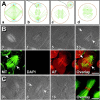Microtubules are the only structural constituent of the spindle apparatus required for induction of cell cleavage
- PMID: 12900392
- PMCID: PMC2172685
- DOI: 10.1083/jcb.200301073
Microtubules are the only structural constituent of the spindle apparatus required for induction of cell cleavage
Abstract
Structural constituents of the spindle apparatus essential for cleavage induction remain undefined. Findings from various cell types using different approaches suggest the importance of all structural constituents, including asters, the central spindle, and chromosomes. In this study, we systematically dissected the role of each constituent in cleavage induction in grasshopper spermatocytes and narrowed the essential one down to bundled microtubules. Using micromanipulation, we produced "cells" containing only asters, a truncated central spindle lacking both asters and chromosomes, or microtubules alone. We show that furrow induction occurs under all circumstances, so long as sufficient microtubules are present. Microtubules, as the only spindle structural constituent, undergo dramatic, stage-specific reorganizations, radiating toward cell cortex in "metaphase," disassembling in "anaphase," and bundling into arrays in "telophase." Furrow induction usually occurs at multisites around microtubule bundles, but only those induced by sustained bundles ingress. We suggest that microtubules, regardless of source, are the only structural constituent of the spindle apparatus essential for cleavage furrow induction.
Figures





References
-
- Bukauskas, F.F., C. Kempf, and R. Weingart. 1992. Cytoplasmic bridges and gap junctions in an insect cell line (Aedes albopictus). Exp. Physiol. 77:903–911. - PubMed
-
- Canman, J.C., D.B. Hoffman, and E.D. Salmon. 2000. The role of pre- and post-anaphase microtubules in the cytokinesis phase of the cell cycle. Curr. Biol. 10:611–614. - PubMed
Publication types
MeSH terms
Substances
LinkOut - more resources
Full Text Sources
Other Literature Sources

